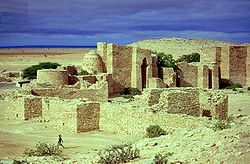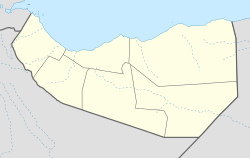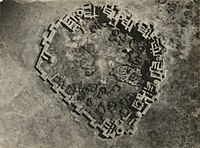| Revision as of 19:48, 14 June 2021 editHeesxiisolehh (talk | contribs)Extended confirmed users2,297 edits Siirski did not explain his revertTags: Undo Reverted← Previous edit | Revision as of 20:37, 14 June 2021 edit undoGebagebo (talk | contribs)Extended confirmed users7,862 edits Restored revision 1028566095 by Dabaqabad (talk): Unsourced changes, restored stable versionTags: Twinkle UndoNext edit → | ||
| Line 11: | Line 11: | ||
| | motto = | | motto = | ||
| | image_skyline = Taleh Castle.jpg | | image_skyline = Taleh Castle.jpg | ||
| | image_caption = The largest Dervish fort |
| image_caption = The largest Dervish fort in Taleh constructed from 1909 to 1910. | ||
| | image_flag = | | image_flag = | ||
| | flag_size = | | flag_size = | ||
| Line 18: | Line 18: | ||
| | image_map = | | image_map = | ||
| | map_caption = | | map_caption = | ||
| | pushpin_map = |
| pushpin_map = Somaliland | ||
| | pushpin_label_position = bottom | | pushpin_label_position = bottom | ||
| | pushpin_mapsize = | | pushpin_mapsize = | ||
| | pushpin_map_caption = Location in |
| pushpin_map_caption = Location in Somaliland | ||
| | subdivision_type = Country | | subdivision_type = Country | ||
| | subdivision_name = {{flag| |
| subdivision_name = {{flag|Somaliland}} | ||
| | subdivision_type1 = ] | | subdivision_type1 = ] | ||
| | subdivision_name1 = ] | | subdivision_name1 = ] | ||
| | subdivision_type2 = ] | | subdivision_type2 = ] | ||
| | subdivision_name2 = ] | | subdivision_name2 = ] | ||
| | government_footnotes = | | government_footnotes = | ||
| Line 57: | Line 57: | ||
| }} | }} | ||
| '''Taleh''' ({{lang-so|Taleex}}, {{lang-ar|تليح}}) is a historical town in the eastern ] region of ].<ref name="Staros"></ref><ref>{{ |
'''Taleh''' ({{lang-so|Taleex}}, {{lang-ar|تليح}}) is a historical town in the eastern ] region of ].<ref name="Staros"></ref><ref>{{Cite web|date=2015-04-23|title=Somaliland oo ciidamo u dirtay Taleex|url=https://www.bbc.com/somali/war/2015/04/150423_ciidanland|access-date=2021-06-14|website=BBC News Somali|language=so}}</ref><ref>{{Cite web|title=Somaliland oo Qabsatay Degmada Taleex|url=https://www.voasomali.com/amp/1893675.html|access-date=2021-06-14|website=www.voasomali.com}}</ref> The town served as the capital of the pre-independence ].<ref name="Laurence">Laurence, p.47.</ref><ref>{{Cite book | url=https://books.google.com/?id=EIxAvWE5FNMC&pg=PA229&dq=dervish+capital+taleh#v=onepage&q=dervish%20capital%20taleh&f=false |title = The World's Most Dangerous Place: Inside the Outlaw State of Somalia|isbn = 9781446487051|last1 = Fergusson|first1 = James|date = 2013-01-17}}</ref> | ||
| The ] and the Taleh complex built between 1909 and 1910 are among the least disfigured Darawiish era structures that remain in Sool province, whom altogether comprise 27 Darawiish era structures. The oldest or first of these forts was the Ugaadhyahan Dhulbahante-inhabited fort at Halin and destroyed by Eric Swayne in 1902;<ref name="officialoperations"/> the second-oldest was the Ali Gheri Dhulbahante-inhabited fort at ] built in 1903.<ref name="official"/> | The ] and the Taleh complex built between 1909 and 1910 are among the least disfigured Darawiish era structures that remain in Sool province, whom altogether comprise 27 Darawiish era structures. The oldest or first of these forts was the Ugaadhyahan Dhulbahante-inhabited fort at Halin and destroyed by Eric Swayne in 1902;<ref name="officialoperations"/> the second-oldest was the Ali Gheri Dhulbahante-inhabited fort at ] built in 1903.<ref name="official"/> | ||
Revision as of 20:37, 14 June 2021
For the villages in Iran, see Taleh, Iran. Town in Sool, Somaliland| Taleh Taleexتليح | |
|---|---|
| Town | |
 The largest Dervish fort in Taleh constructed from 1909 to 1910. The largest Dervish fort in Taleh constructed from 1909 to 1910. | |
 | |
| Coordinates: 9°8′51″N 48°25′15″E / 9.14750°N 48.42083°E / 9.14750; 48.42083 | |
| Country | |
| Region | Sool |
| District | Taleh |
| Population | |
| • Total | 25,354 |
| Time zone | UTC+3 (EAT) |
Taleh (Template:Lang-so, Template:Lang-ar) is a historical town in the eastern Sool region of Somaliland. The town served as the capital of the pre-independence Dervish movement.
The Dalyare fort and the Taleh complex built between 1909 and 1910 are among the least disfigured Darawiish era structures that remain in Sool province, whom altogether comprise 27 Darawiish era structures. The oldest or first of these forts was the Ugaadhyahan Dhulbahante-inhabited fort at Halin and destroyed by Eric Swayne in 1902; the second-oldest was the Ali Gheri Dhulbahante-inhabited fort at Eyl built in 1903.
Taleh succeeded the city of Eyl (Illig) as Darawiish capital, which had been the capital for four years from 1905 onwards when it was inhabited by the Dervish.
History
Main article: Dervish StateSayid's description
In the Sayid's description of the fall of Taleh in February 1920, in an April 1920 letter transcribed from the original Arabic script into Italian by the incumbent Governatori della Somalia, the various Darawiish-built installations are described as garesas taken from the Dhulbahante clan by the British:
|
i Dulbohanta nella maggior parte si sono arresi agli inglesi e han loro consegnato ventisette garese (case) ricolme di fucili, munizioni e danaro. |
the Dhulbahante surrendered for the most part to the British and handed twenty-seven garesas (houses) full of guns, ammunition and money over to them. |
Choice as capital

According to Darawiish veteran Ciise Faarax Fikad, Taleh was chosen as the Darawiish capital because the Nugaal Valley lies at the heartland of Dhulbahante territory, its distance from colonial administrative centers and to generate geographical distance from the hostile bodies such as Rayid signatories to British treaties, the Majeerteen, those under Mohamoud Ali Shire and the Ogaden who were in general opposed to the Darawiish:
|
Iyadoo nimankii dalka waagii hore degi jirey ( Dhulbahante ) ay Sayidka ku dirqiyeen in Nugaal la dego ... Ingiriis iyo dadka raacsan iyo Daraawiish waxa ka dhexeeya colaad guun ah oo aan damihayn ... Maxamuud Cali Shire waynu dagaallannay ... Boqor Cismaan iyo raggiisii Talyaani baa dab ku afuufay oo iyaguna horeynu u collownay ... Cali Yuusuf ... Ogaadeen in yar mooyee Xabashi baa dabada ka wadda oo dagaalkii Gurdumi bay inooku dudayaan iyana waa inoo col. |
The native inhabitants of the Nugaal Valley, i.e. the Dhulbahante are those whom insisted it be made the Darawiish capital ... There was enmity and antagonism between Darawiish and the Somali signatories of British treaties ... we've fought Mahamoud Ali Shire ... The Majeerteen kings Cismaan and Ali Yusuf have been armed by the Italians in order to harm Darawiish and we've clashed before ... the vast majority of Ogaden are allied with the Abbysinians and the Ogaden showed their true colors during the Gurdumi incident when they became overt foes. |
Colonial sources concur with Somali sources that non-Dhulbahante clans were hostile towards the Darawiish:
The coast tribes , viz . , the Habr Toljaala , the Habr Gerhajis , the Warsangli of our own Protectorate , and the Mijjarten tribes of the Italian Protectorate were all professedly hostile to the Mullah.
— Charles Egerton (Indian Army officer)
Taleh forts
Although the term Taleh or Taleex is often used to describe the entire Dervish fort complex in the town, it more strictly applies to only one of the structures in a four-part compound. The latter complex includes Falat, Silsilad, Dar Ilaalo and Taleh.
The main fortress, Silsilat, is about 350 feet long by 300 feet broad. The two buildings next in importance are Dar llalo, the look-out tower, some 50 feet high, built on the top of a hillock close behind Silsilat, and Taleh (in a restricted sense) of similar height, built on lower ground to the east.
According to Jardine, prior to Taleh becoming Darawiish capital, the Darawiish capital had for four years from 1905 onwards been at Eyl, also known as Illig:
Thus the Mullah became an Italian-protected subject; and during the three years that followed, his haroun remained in the neighbourhood of Illig.
Conception
The notion of the building of fortresses for Darawiish inhabitation pre-existed 1902 as Eric Swayne encountered a fort at Halin during the second expedition in 1902, as such, arguably timeframing the building of the Halin fort at 1901. The British War Office stated that Eric Swayne destroyed the fort in 1902, and that it was inhabited by the Ugaadhyahan Dhulbahante subclans of Naleye Ahmed and Nur Ahmed:
a detached force proceeded the same night to Biyu Gudud and attacked the Naliya Ahmed and Nur Ahmed, the pursuit being carried into the plain of the Northern Hand as far as Kol Dorran. Some guns and ammunition were captured and the tribes fled northward towards some wells about 60 miles from the sea. The whole force then returned to Biyu Gudud on the 1st August, and the dervish fort at Halin (9 miles N.N.E. of Lower Halin) was destroyed.
The second-oldest Dhulbahante fort of the Darawiish era is the Dhowre Sheneeleh fort which was constructed at Eyl (Illig) in 1903. According to the British War Office, the castle at Illig was exclusively inhabited by the Dhulbahante clan, and in particular by the Ali Gheri subclan of the Dhulbahante:
The Mullah, with practically only his Ali Gheri following, is a discredited refugee in the Mijjarten territory, at the mercy of Osman Mahmud. His actual capture by the field force is, under present conditions, in my opinion impracticable ... the operations already ordered for the capture of lllig and dealing a last blow at the Mullah are to be carried out
Historian Douglas Jardine concurs with the British War Office that the Darawiish capital at Illig (Eyl) was exclusively inhabited by the Dhulbahante:
while the Mullah's Dolbahanta allies had retreated south-east towards Illig, the Mullah himself, with all his sheep and goats, but abandoning his camels, bullocks, and ponies, had fled post-haste across the waterless Haud to Mudug.
Dervish forts/Dhulbahante garesas


Taleh is home to several historic structures dating to the Darawiish era. Of these, there are five forts erected by Mohammed Abdullah Hassan's former Dervish movement in present-day Sool and Sanaag. Constructed between 1901 and 1915, most of the edifices are concentrated in the Sanaag & Sool region, including Dalyare fort, Jidali fort, Midhisho, Shimbir Bariis and Badhan. Taleh/Taleex is the largest of the structures. According to Cabdi-Yaar Cali Guuleed, a Darawiish veteran, the largest Dhulbahante fort from the Darawiish era is the Dhulbahante fort of Taleh which according to him was built between 1909 to 1910 and he said the following:
|
Waa xaruntii Daraawiisheed, waxayna ku taal bartamaha Nugaaleed, dhinaca waqooyi. Waxaa la dhisay 1909-1910. |
It was the headquarters of the Darawiish, and it is situated in the center of the Nugaal Valley, in a northern direction. It was built between 1909 to 1910 |
It was built around a collection of Dervish tombs, the earliest of which belongs to Sultan Nur Ahmed Aman and Carro Seed Magan, the Dervish leader Hassan's mother. From 1909 to 1910, the Dervish constructed the main fort around the older tombs. They spent the next two years in the mountainous regions of Sanaag building three more smaller forts.
Maxamuud Xoosh Cigaal was the last Darawiish man to be resident at the Taleh fort, whilst the six-year old Jaamac Biixi Kidin was the last Darawiish person in the fort overall.
A 1931 diary-book by former Italian Somalia governor Francesco Caroselli notes an April 1920 letter by the Sayid to the then Italian-Somalia governor which states the Taleh fort was one of 27 forts built by Darawiish and that they're called Dhulbahante garesas.
|
Gl’Inglesi che sapevano questo ci son piombati addosso con tutta la gente e con sei volatili (aeroplani). Per tal fatto ci siamo sabandati e non c’e’ stato piu’ accordo fra di noi: i Dulbohanta nella maggior parte si sono arresi agli inglesi c han loro consegnato ventisette garese (case) ricolme di fucili, munizioni e danaro ... E ora diciamo ... desideriamo tu faccia qualcosa per noi nel senso di intervenire fra noi e gli inglesi per restituirci le nostre famiglie, figili, beni, terrtori. E cosi c’impegnamo sopra la nostra anima di stare in pace, tranquilli e di non disturbare mai piu’ le altre genti ee prenderemo la te la bandiera ... Saluti |
The English knew about our situation and yet pounced upon us with all their men and with six birds (airplanes). Because of this, we scattered and dispersed as there was no longer an agreement between us: most of the Dhulbahante tribe surrendered to the British who confiscated from them twenty-seven garesas (houses) full of rifles, ammunition and money ... As such ... we request from you, ... to become mediators between ourselves and the British, as we aspire that they restore to us our stolen families, our stolen children, our stolen wealth, and our stolen territory; in this way we may enter into equitable cooperation of peace and tranquility, such that we remain quiescent, and that we take your flag. Greetings. |
Fall of Taleh
See also: Somaliland campaign (1920)In 1919–1920, the British bombarded the Sanaag forts, where most of the Dervish had operated since 1913. Having destroyed the structures and driven out Hassan's men to Taleh in 1920, they finally attacked the town, assisted by horsemen and Somali personalities. The settlement was bombarded by the Royal Air Force on 4 February and taken days later, with the British having defeated the last pockets of Dervish resistance. Among the casualties at Taleh were Ibrahim Buqul and Haji Sudi, two of the closest men to the Mullah and both being of the Adan Madobe sub-division of the Habr Je'lo. The former was the commander of the Dervish at Taleh, and the latter was a long-standing member of the movement according to Douglas Jardin (1923) and Henry Rayne (1921). Another Dervish leader, Yusuf Xayle, was captured alive and later executed by former Dervish Abdi Dhere, who had defected to the opposition in 1919. Hassan himself managed to escape to the Ogaden, where his Dervishes were later routed in a 1921 raid led by the clan leader Haji Warabe.

Demographics
The broader Taleh District has a total population of 45,354 residents, with the Dhulbahante as the native people of the land
Climate
| Climate data for Taleh | |||||||||||||
|---|---|---|---|---|---|---|---|---|---|---|---|---|---|
| Month | Jan | Feb | Mar | Apr | May | Jun | Jul | Aug | Sep | Oct | Nov | Dec | Year |
| Mean daily maximum °C (°F) | 29.5 (85.1) |
30.3 (86.5) |
31.9 (89.4) |
33.2 (91.8) |
34.0 (93.2) |
32.9 (91.2) |
31.9 (89.4) |
32.6 (90.7) |
34.0 (93.2) |
32.7 (90.9) |
31.1 (88.0) |
29.7 (85.5) |
32.0 (89.6) |
| Mean daily minimum °C (°F) | 14.0 (57.2) |
15.1 (59.2) |
16.2 (61.2) |
19.1 (66.4) |
20.8 (69.4) |
21.4 (70.5) |
21.4 (70.5) |
21.1 (70.0) |
21.0 (69.8) |
18.6 (65.5) |
15.6 (60.1) |
14.9 (58.8) |
18.3 (64.9) |
| Average precipitation mm (inches) | 1 (0.0) |
1 (0.0) |
3 (0.1) |
19 (0.7) |
39 (1.5) |
3 (0.1) |
1 (0.0) |
1 (0.0) |
10 (0.4) |
24 (0.9) |
7 (0.3) |
2 (0.1) |
111 (4.1) |
| Source: Climate-Data.org | |||||||||||||
Education
Taleh has a number of academic institutions. According to the Somaliland Ministry of Education, there are eight primary schools in the Taleh District. Among these are Kalad, Labas, Aroley and Halin.
Notable residents
- Abdisamad Ali Shire – former Vice President of Puntland
- Abdihakim Abdullahi Haji Omar – current Vice President of Puntland
- Saado Ali Warsame – a Somali singer-songwriter and former politician
Notes
- "Regions, districts, and their populations: Somalia 2005 (draft)" (PDF). UNDP. Retrieved 21 September 2013.
- Regions of Somalia
- "Somaliland oo ciidamo u dirtay Taleex". BBC News Somali (in Somali). 2015-04-23. Retrieved 2021-06-14.
- "Somaliland oo Qabsatay Degmada Taleex". www.voasomali.com. Retrieved 2021-06-14.
- Laurence, p.47.
- Fergusson, James (2013-01-17). The World's Most Dangerous Place: Inside the Outlaw State of Somalia. ISBN 9781446487051.
- ^ Official History of the Operations in Somaliland, 1901-04 Great Britain. War Office. General Staff · 1907 , PAGE 100
- ^ Official History of the Operations in Somaliland, 1901-04 Great Britain. War Office. General Staff · 1907 , PAGE 264
- ^ Mad Mullah of Somaliland, Douglas Jardine, p 148
- ^ Ferro e Fuoco in Somalia, da Francesco Saverio Caroselli, Rome, 1931; p. 272.
- Ciise, Jaamac (1976). Taariikhdii daraawiishta iyo Sayid Maxamed Cabdulle Xasan.
Per tal fatto ci siamo sabandati e non c'e ' stato piu ' accordo fra di noi : i Dulbohanta nella maggior parte si sono arresi agli inglesi c han loro consegnato ventisette garese case ) ricolme di fucili , munizioni e danaro .
- Ciise, Jama. Taariikhdii Daraawiishta iyo Sayid Maxamed Cabdulle Xasan. 2005, p 251
- Official History of the Operations in Somaliland, 1901-04 War Office. General Staff · 1907 , PAGE 252
- ^ The Geographical Journal, Vol. 78, No. 2 (Aug., 1931), pp. 125-128
- Diiwaanka gabayadii, 1856-1921 -Maxamad Cabdulle Xasan · 1999 , PAGE 184
- Taariikhdii daraawiishta iyo Sayid Maxamad Cabdille Xasan, Jaamac Cumar Ciise · 2005 , PAGE 325
- Darwiish Jaamac Biixi Kidin Oo Maanta Ku Geeriyoodey Magaalada Garoowe. Written by Asad Cadaani Ibraahim Saturday, 01 August 2009
- The Times, 18 February 1920, p. 9 and Illustrated London News and the Sphere, both of 17 April 1920
- Douglas Jardine, 'The Mad Mullah of Somaliland.' 8vo. London 1923.
- "Regions, districts, and their populations: Somalia 2005 (draft)" (PDF). UNDP. Retrieved 21 September 2013.
References
- Laurence, Margaret; Nora Foster Stovel (2003). Heart of a stranger. University of Alberta. ISBN 9780888644077.
- Taleex
9°8′51″N 48°25′15″E / 9.14750°N 48.42083°E / 9.14750; 48.42083
Category: